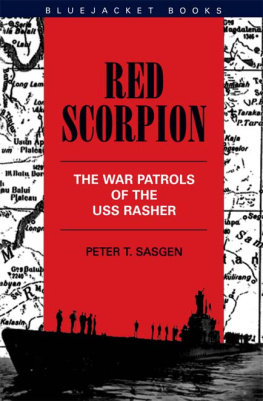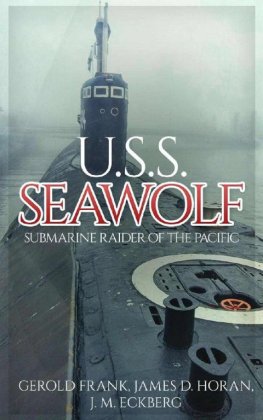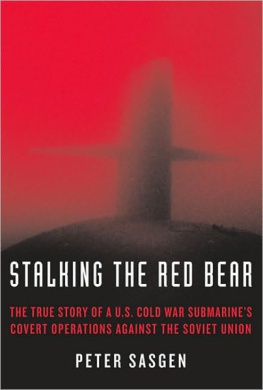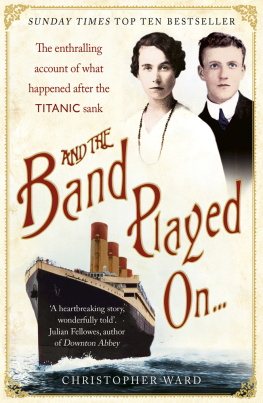Red Scorpion
This book has been brought to publication with the generous assistance of Marguerite and Gerry Lenfest.
RED SCORPION
The War Patrols of the USS Rasher
Peter T. Sasgen

BLUEJACKET BOOKS
Naval Institute Press
Annapolis, Maryland
This book has been brought to publication by the generous assistance of Marguerite and Gerry Lenfest.
Naval Institute Press
291 Wood Road
Annapolis, MD 21402
1995 by Peter T. Sasgen
All rights reserved. No part of this book may be reproduced or utilized in any form or by any means, electronic or mechanical, including photocopying and recording, or by any information storage and retrieval system, without permission in writing from the publisher.
First Bluejacket Books printing, 2002
Library of Congress Cataloging-in-Publication Data
Sasgen, Peter T., 1941
Red scorpion: the war patrol of the USS Rasher / Peter T. Sasgen.
p. cm. (Bluejacket books)
Originally published: Annapolis: Naval Institute Press, 1995.
Includes bibliographical references and index.
ISBN 978-1-61251-284-6 (alk. paper)
1. Rasher (Submarine) 2. World War, 19391945Naval operations, American. 3. World War, 19391945Naval operationsSubmarine. 4. World War, 19391945CampaignsPacific Area.
I. Title. II. Series.
D783.5.R37 S27 2002
940.545973dc21
2002070343
Statistics from John D. Alden, U.S. Submarine Attacks During World War II are reprinted by permission of the United States Naval Institute. Photo credits: Sasgen, collection of Peter T. Sasgen; Hutchinson, collection of Peter J. Sasgen; Laughon, courtesy of Capt. William Norrington, USN (Ret.); Munson, official U.S. Navy photo; Adams, collection of Peter J. Sasgen; Nace, courtesy of Rear Adm. Charles D. Nace, USN (Ret.).
To the officers and men of the USS Rasher
Contents
Rasher:Sebastes miniatus. A venomous vermillion and white scorpionfish (or rockfish). Its habitat is the sandy bottom and rocky coastline from British Columbia, Canada, to Baja, Mexico. Rashers grow to 30 inches in length and thrive in water up to 150 fathoms deep. Their poison glands lie under the base of deeply grooved spines and transmit a paralyzing sting.
From a standard work on marine biology
USS Rasher (SS 269): a Gato-class attack submarine laid down on 4 May 1942, by Manitowoc Shipbuilding Company, Manitowoc, Wisconsin; launched 20 December 1942; commissioned 8 June 1943.
From The Dictionary of American Naval Fighting Ships
A series of events that helped make this book a reality must be mentioned. When my father, Peter J. Sasgen, was undergoing treatment for cancer in December of 1991, I telephoned his old friend, Rear Adm. Charles D. Nace, whom Id never met but most certainly knew from Dads war stories. I was aware of their mutual high regard for each other, developed when both were aboard the Rasher on her seventh and eighth war patrols, Dad as an engineering officer, Chuck in command. I explained the situation to the retired admiral and suggested that a letter to Pete might be just what was needed at that juncture. Chuck agreed; he was delighted to have located his old shipmate, having lost track of him in the seventies. He also took the time to contact some of Dads other shipmates to apprise them of the situation. Needless to say, Dad was overwhelmed (flabbergasted, one of his favorite words, would be more like it) when he received Chucks letter. The letter precipitated a phone conversation between the two. It was, quite literally, all Pete talked about for weeks afterward. Fortuitously, the letter arrived just before the January 1992 Rasher reunion, held in Lakeland, Florida, and set in motion a visit by several of Dads shipmates to his home in Spring Hill, Florida. It was like a private reunion. A month later, Dad passed away. I find it difficult even now to know how to express my thanks to all those who visited him or later wrote to express their sorrow at his death.
Afterward, I began to peruse the RASHER REPORT newsletters that someone thoughtfully had given him, along with some pictures and letters from the Lakeland reunion. I was so taken with the depth of involvement with the Rasher and her exploits by former crew members that I got in touch with Bob Mathewson, who filled me in on reunion activities, particularly the one planned for Manitowoc in 1993 to celebrate the fiftieth anniversary of the Rashers commissioning. Next, I talked to Bill Norrington, and he piqued my interest even more. Then in March, I got the notion that it would be interesting to locate the Rashers original builders plans and blueprints and... well, you get the idea.
Being a closet submarine buff, I was impelled by my fathers death to pull together the disparate parts of the Rashers story. That story is an adventure of the first order, replete with perils and triumphs, heroics and tragedy; an adventure that has always held a powerful fascination for me.
Writing a book about the Rasher was quite a challenge. For one thing, the events took place more than fifty years ago. For another, having been born in 1941, I wasnt aboard when she went to war in 1943. But my father was, and that fact has been a part of my life since the day in 1942 when he reenlisted in submarine service and was assigned to the Rasher, then under construction in Manitowoc, Wisconsin. So in a way Ive always felt that I was aboard.
I was unprepared for the mountain of information relevant to the Rashers war years that had to be digested. Flipping through my fathers memorabilia and scrapbooks was one thing; reading and understanding patrol reports and deck logs was quite another, to say nothing of the individual reminiscences and personal papers of her former crew members, declassified Navy documents, submarine history, submarine tactics, charts, letters, pictures, fleet submarine technical manuals, old service recordsand that was just the easy part. For instance, Edward Hutchinsons reports are tersely written descriptions lacking the minutia of day-to-day patrolling, while Willard Laughons are minute-by-minute (sometimes second-by-second), blow-by-blow accounts that read like a novel; Henry Munsons are supplemented with detailed attack diagrams. How to use this stuff and how best to convert it into a narrative of my own? That was only one of many problems I confronted that made the challenge all the more exciting.
To my amazement, much of the material I needed was readily available in government archives and libraries. At times I likened the search to an archaeological dig in which Id occasionally come across a treasure in the flimsy, crumbling documents in some long-forgotten file.
Always over my shoulder as I started to weave the story together, I felt the presence of the Rashers crew. Would they approve of my efforts, would they agree with my interpretation of things, much less my technical grasp of tactics and events that took place nearly half a century ago? Could I count on their memories being foggy enough to overlook distortions and outright mistakes should they creep in? And also, was it okay for me to do this as opposed to someone who served in the Rasher? I knew my dad would have approved, but what about everyone else? These were real concerns. As for the issue of my authoring this work, my wife, Karen, asked, Who better to do it? Bill Norrington essentially said the same thing. So, I decided I would take a direct and steadfast approach; I would write it the way I wanted it to be written, and I would decide what was important and what was not. The interpretations would be mine alone, and I would try to make it rich in detail and exciting to read.
Next page







